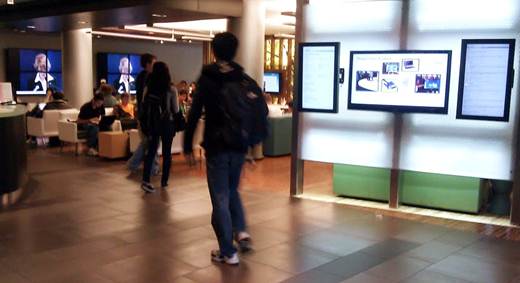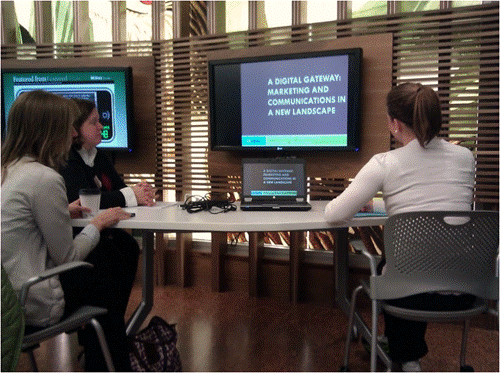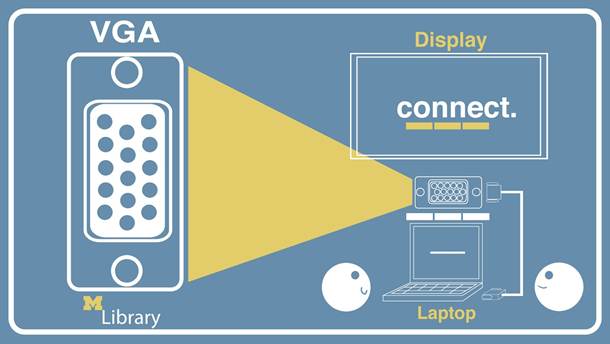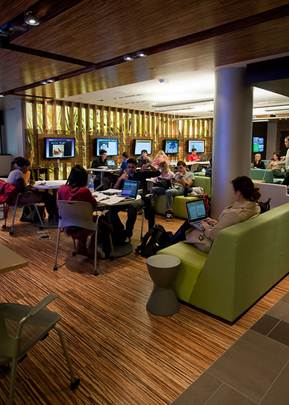Key Takeaways
- Like many institutions, the Shapiro Library invested in a space renovation of its lobby to support student learning by fostering collaboration, offering technology-rich resources, and connecting to academic programs.
- What wasn’t clear was why students failed to use the technology allowing them to plug in their laptops and project their work onto large screens for collaborative work.
- The library lobby team began modeling use of the projection feature when advertising alone did not increase use of the new plug-and-project capability.
- Although student use of projection technology in the lobby is increasing, progress is slow; simply getting the word out about these new learning space options continues to be the biggest hurdle.
In the first year after the Shapiro Library at the University of Michigan undertook a renovation of a large lobby space on the first floor of the building, we were surprised to find that one of the embedded technology options wasn’t being used much, and we didn’t know why.
Learning technologies offer us the opportunity to think about our spaces in new ways. We learned a great deal from this renovation, including some unexpected lessons that we can transfer to future projects. Like many institutions, we invested in this space renovation to better support student learning by fostering collaboration, offering technology-rich resources, and connecting to academic programs. Although we found that the new space achieved some of these outcomes, it didn’t achieve all of them. Specifically, students now had the capability to plug in laptops and project their work onto large screens in order to work more effectively in a collaborative environment. The problem was, we didn't see anyone plugging in. Exploring the reasons why this capacity did not appear to be in demand led to an observational study and our subsequent recommendations on how to effectively market new technology tools to students.
The Space
Bert’s Study Lounge is a newly renovated student space near the entrance of the Shapiro Library, a popular study destination for undergraduate students. The 2011 transformation of the underused library lobby into a technology-rich study lounge was funded by a generous gift from Bertram J. Askwith, an alumnus of the university. The mission was to create an inviting space with technical capabilities to support collaborative and peer learning. During the planning process, focus groups with undergraduate students indicated a need for a space suitable for collaborative work with mobile computers. In addition to movable furniture and dozens of well-spaced power outlets, the study lounge featured over a dozen digital screens.

Since the mission of the study lounge was to support collaborative learning, the technology in the space was designed to support group work. Eight of screens had the capacity for users to project their laptop screens via VGA cables. The function was designed to be as seamless as possible. Once a user connects a cable to a port beneath a screen, the screen display automatically switches to the VGA input. The large wall-mounted screen shows the content on the laptop, allowing groups to comfortably view digital content together.

We wanted to make sure, however, that the screens would not lie dormant when not in use for projection. Each screen was connected to a compact Mac minicomputer and had the capability to display myriad formats of digital content. Using a content management system, FourWinds, we were able to remotely manage slideshows, static images, and videos. The digital screens provided a venue for library promotions and signage, as well as creative content from students and campus departments.
Over the first year Bert’s Study Lounge was open, it became a hugely popular destination for students. A convenient location near the library entrance, numerous power outlets, comfortable furniture, and proximity to the freely flowing coffee at a nearby café proved to be a productive combination for group work.
We noticed, however, that few students used the capacity for screen projection, despite VGA cables available for checkout at the circulation desk just a few steps away. We initially wondered if students did not see a need for the technology. In casual observation, however, we still noticed groups of students drawing together around small notebook computer screens for collaborative work. We also worried that students were aware they could plug in, but did not know they could check out the proper cable from the circulation desk nearby.
We slowly developed a theory that students were simply unaware of this cool new feature. To be fair, the VGA ports were subtly integrated in the design of the lobby. Adding to the obfuscation, the creative content we’d solicited from students and/or created ourselves was so compelling, it seemed to users as though it were the raison d’etre for the screens.
It seemed that our fun new projection feature was operating incognito.
Working under the assumption that users were unaware of the capability of projection, we created an advertising campaign with images of VGA cables and brief instructions. We displayed the ads digitally on the very same screens used for projection, saying “Plug In Here.” Unfortunately, the advertisements had little noticeable effect on the number of users projecting their screens.

Graphic by Adam Buttrick
The lobby team decided to dig deeper into the reasons why few students took advantage of the ability to project. We conducted an observational study supplemented with brief surveys. Our study investigated whether students were simply unaware of the projection function in the lobby, or if there were unknown barriers to use.
Observation
Over one month (March 2012 to April 2012), we observed 179 students and surveyed 46 students studying in groups. We asked about why the groups were meeting, the mobile devices they had with them, whether they knew the screens were available for projection, whether they knew how to use the projection function, and what barriers they might encounter with screen projection. Our observation times ranged from 10 a.m. to 1 a.m., with student groups studying everything from nursing to calculus.
Findings
Our suspicion that the functionality went unused because students were unaware of the capability was confirmed. Only half of the student groups surveyed had at least one member who knew the lounge screens were available for projection. Despite a multi-month marketing scheme concentrated in the physical space of the study lounge, our message was not received.

Photo by Jude Walton Photography
Students still said, however, that the projection functionality was highly desirable, with 90 percent of surveyed groups indicating that projection would be useful for group work. Many groups, once told projection was available, immediately wanted to use it. We also found, however, that many students surveyed cited privacy as a potential issue when considering projection. We conjecture that the issue of “privacy” might be more complex than simply safeguarding intellectual work. The lobby is a popular, high-traffic destination, and screen projection is a highly conspicuous activity. Students may be uncomfortable being the first to experiment with a new technology in full view of their peers.
Educational Technologies Librarian Diana Perpich explains in this video (2:34 minutes) how she uses the lobby space in her work, and students express their reactions to the projection capability:
Since advertisements about projection were not penetrating the public consciousness, we needed to consider other ways to raise awareness. We realized that simply modeling the behavior might be the best publicity tool. Since screen projection was relatively new in the library setting, students were unlikely to start using it unless they saw others doing it first.
The lobby coordination group started to take advantage of the technology ourselves. Screen projection came in handy when editing slides for a group presentation or reviewing new work created for display on the screens. By checking out VGA cables, hooking up a laptop, and spending time doing group work in the study lounge, we modeled projection over and over. We had also spread the word about plugging in to faculty and staff throughout the library, and occasionally saw others having meetings in the space and using the technology.
As time went on, we noticed more students projecting their screens. The technology was slowly taking root in campus study culture. One day, we thought the content management system was on the fritz, because the large video wall was filled with lines of code, but we suddenly realized a pair of students was writing collaborative code. We also were excited to find that a TedX student organization took over the screens for an afternoon of guerrilla marketing to promote an upcoming event. Soon we began to see more groups of students using projection for brainstorming, writing, and working on presentations.
Further evidence of success came this summer, when participants in the University of Michigan Debate Camp poured into the library. These focused and competitive high school students immediately saw the advantages of screen projection for their time-sensitive group work. We encountered a new, easily remedied problem: too few VGA cables available for checkout. Projection was finally taking hold in campus study culture.
Pushing and Trailing Simultaneously
Screen projection was novel to our students. We responded to focus groups asking for collaborative functions, but once we implemented the technology, we had to educate new users. It was a challenge to find that once we completed renovations and had wonderful new resources, we had to push a new technology to get people to use it.
At the same time, the new technology that we were pushing was declining slightly as the standard, so we were simultaneously pushing the technology and trailing technology standards. We chose VGA connections for the displays due to their ubiquity as computer-to-projector connectors. In the dawning era of ultralight notebooks, however, student computers may not have VGA capabilities. A particular challenge for our study lounge has been to continue providing Apple VGA adapters and, more recently, HDMI adapters.
Recommendations
New technologies can be a valuable addition to student work, but students don’t necessarily adapt to them immediately. Having faced the challenge of offering a technology that went largely unused, we have a few recommendations for institutions designing collaborative study spaces.
- Make it obvious.
- Market it.
- Model it.
- Modify as needed.
Make It Obvious
Subtly integrated technology makes for attractive spaces, but student users are so focused on finding a study spot that they’ll easily miss upgrades. Make sure the physical aspects of the new technology are clearly highlighted. Clearly worded labels are key. Large, red arrows are worth considering. We have even explored the option of designing a way to make the cables visible in a location adjacent to the screen outlet: a Lucite box or wall clip that would remove the step of leaving the table to check out equipment.
Market It
Underlining the physical presence of a new technology is the first step; marketing is the second step. Now that a user knows the new technology exists, help them understand how it helps their academic work. We continuously create ads to communicate the capabilities of the space to students and even took a week at the beginning of fall semester to flood several of the screens with messages about plugging in and sharing your work. In the higher education setting, every fall is an opportunity to market services to new students.
Model It
Even after students hear about a new capability and think it might be useful to them, they may be reluctant to spend valuable study time fumbling with it. Seeding the space with experienced users will organically spread the use of the new technology. We try to use projection function whenever we need to view documents as a group, but as our own promotional efforts succeed, it gets harder to find an open screen.
Modify as Needed
The hard truth about providing new technologies is that soon enough, they’ll no longer be new. Student technology needs, especially those related to mobile devices, are a constantly moving target. Be prepared to update and adapt as necessary. We continually review our connector cable offerings and purchase new adapters, for example.
Conclusion
Students in higher education increasingly look for study spaces conducive to collaborative work, but it’s not enough to build the environment and walk away. Although we are starting to see changes in the collaborative culture of the space, with more students plugging in, it’s still not an everyday occurrence. We continue to create new marketing images for the screens and plug in and project our own work on a regular basis, and we’re even considering occasionally walking through the space offering cables to likely student groups who do not know they are available. An important message we are trying to impart is the idea that the students should feel ownership of the space. The easily movable furniture is another subtle message to the students: grab a coffee, roll the furniture where you need it, plug in, and share your work.
We are confident that this new technical capability is something that will help students work more efficiently, and may even inspire them to create new and exciting media-rich projects. Simply getting the word out about these new learning space options continues to be the biggest hurdle.
© 2012 Megan McGlynn, Amanda Peters, and Shae Rafferty. The text of this EDUCAUSE Review Online article is licensed under the Creative Commons Attribution-NonCommercial-NoDerivs 3.0 license.
